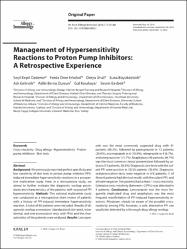| dc.contributor.author | Özdemir, Seçil Kepil | |
| dc.contributor.author | Erkekol, Ferda Öner | |
| dc.contributor.author | Ünal, Derya | |
| dc.contributor.author | Büyüköztürk, Suna | |
| dc.contributor.author | Gelincik, Aslı | |
| dc.contributor.author | Dursun, Adile Berna | |
| dc.contributor.author | Karakaya, Gül | |
| dc.contributor.author | Bavbek, Sevim | |
| dc.date.accessioned | 2020-12-19T19:55:57Z | |
| dc.date.available | 2020-12-19T19:55:57Z | |
| dc.date.issued | 2016 | |
| dc.identifier.citation | Kepil Özdemir, S., Öner Erkekol, F., Ünal, D., Büyüköztürk, S., Gelincik, A., Dursun, A. B., Karakaya, G., & Bavbek, S. (2016). Management of Hypersensitivity Reactions to Proton Pump Inhibitors: A Retrospective Experience. International archives of allergy and immunology, 171(1), 54–60. https://doi.org/10.1159/000450952 | en_US |
| dc.identifier.issn | 1018-2438 | |
| dc.identifier.issn | 1423-0097 | |
| dc.identifier.uri | https://doi.org/10.1159/000450952 | |
| dc.identifier.uri | https://hdl.handle.net/11436/2639 | |
| dc.description | Bavbek, Sevim/0000-0002-7884-0830; Dursun, A. Berna/0000-0002-6337-6326 | en_US |
| dc.description | WOS: 000388446500005 | en_US |
| dc.description | PubMed: 27838693 | en_US |
| dc.description.abstract | Background: We previously reported perfect specificity and low sensitivity of skin tests in proton pump inhibitor (PPI)-induced immediate hypersensitivity reactions in a prospective multicenter study. Here, in a retrospective study, we aimed to further evaluate the diagnostic workup procedures and characteristics of the patients with suspected PPI hypersensitivity. Methods: This national multicenter study was conducted as a retrospective chart review of patients with a history of PPI-induced immediate hypersensitivity reaction. A total of 60 patients were included. Results of diagnostic workup procedures (standardized skin-prick, intradermal, and oral-provocation tests with PPIs) and the characteristics of the patients were analyzed. Results: Lansopra-zole was the most commonly suspected drug with 41 patients (68.3%), followed by pantoprazole in 12 patients (20.0%), esomeprazole in 6 (10.0%), rabeprazole in 4 (6.7%), and omeprazole in 1 (1.7%). Anaphylaxis (40 patients, 66.7%) was the most common clinical presentation followed by urticaria (17 patients, 28.3%). Diagnostic skin tests with the culprit PPI were positive in 13/26 patients (50.0%). Diagnostic oral-provocation tests were negative in 6/8 patients; 5 of these 6 patients had skin test results with the culprit PPI, and all were negative. Ten patients had at least 1 cross-reactivity. Extensive cross-reactivity (between > 2 PPIs) was detected in 4 patients. Conclusions: Lansoprazole was the most frequently implicated drug and anaphylaxis was the most frequent manifestation of PPI-induced hypersensitivity reactions. Physicians should be aware of the possible crossreactivity among PPIs; however, a safe, alternative PPI can usually be detected by a thorough drug allergy workup. (C) 2016 S. Karger AG, Basel | en_US |
| dc.language.iso | eng | en_US |
| dc.publisher | Karger | en_US |
| dc.rights | info:eu-repo/semantics/openAccess | en_US |
| dc.subject | Cross-reactivity | en_US |
| dc.subject | Drug allergy | en_US |
| dc.subject | Hypersensitivity | en_US |
| dc.subject | Proton pump inhibitors | en_US |
| dc.subject | Skin tests | en_US |
| dc.title | Management of hypersensitivity reactions to proton pump inhibitors: A retrospective experience | en_US |
| dc.type | article | en_US |
| dc.contributor.department | RTEÜ, Tıp Fakültesi, Dahili Tıp Bilimleri Bölümü | en_US |
| dc.contributor.institutionauthor | Dursun, Adile Berna | |
| dc.identifier.doi | 10.1159/000450952 | |
| dc.identifier.volume | 171 | en_US |
| dc.identifier.issue | 1 | en_US |
| dc.identifier.startpage | 54 | en_US |
| dc.identifier.endpage | 60 | en_US |
| dc.relation.journal | International Archives of Allergy and Immunology | en_US |
| dc.relation.publicationcategory | Makale - Uluslararası Hakemli Dergi - Kurum Öğretim Elemanı | en_US |


















